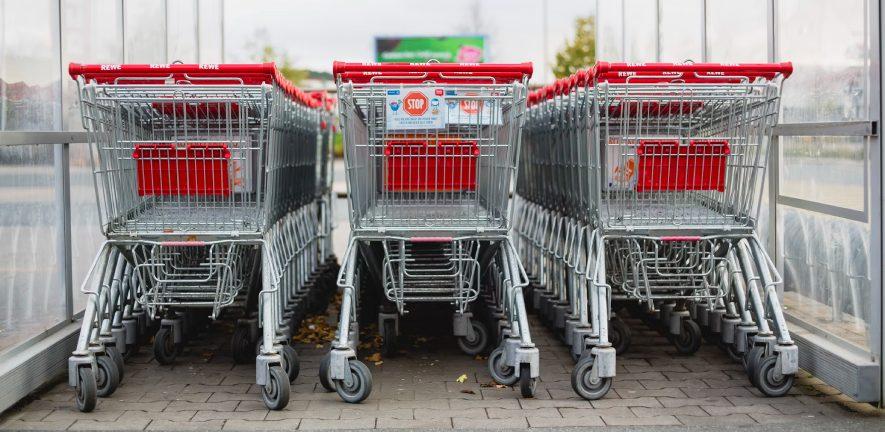
3 April 2024 - Publicly-funded social infrastructure is disappearing, but supermarkets and other retailers are providing communities with much-needed space and resources. Caroline Lee and Rosa Marks ask if it is time to recognise supermarkets as social infrastructure.
“A great human meeting place.” 1
It may come as a surprise that what Nobel-Prize-winning author, Annie Ernaux, was describing here was her local supermarket. But Ernaux recognised something that policymakers have perhaps long overlooked – how supermarkets function as social spaces.
Research by the Bennett Institute and the Institute for Community Studies, funded by Power to Change, revealed that people in the UK rarely distinguish between public and privately-owned spaces when thinking about where they interact socially. So, although supermarkets and other retailers are generally privately-owned and focused on making profit, they nevertheless deliver social benefits, whether intentionally or not.
It is no wonder that with their relative accessibility, embeddedness within everyday life, and opportunities to chat, communities value supermarkets for far more than the products they sell. This forms part of a wider project undertaking research into the social value of supermarkets and why these and other retail spaces should be given greater recognition within discussions on social infrastructure.
Supermarkets as incidental social spaces
A wide spectrum of social encounters occurs constantly in supermarkets, most of which are not deliberately cultivated by the business’s owners. These range from bumping into or spending time with friends or family to merely sharing the same space with others. In the middle lie those incidental, often brief, interactions with acquaintances or strangers, whether that be a short conversation with a member of staff or simply a nod and smile with another customer.
These social interactions have a wide range of benefits, including reducing loneliness and improving well-being, particularly for the elderly, many of whom visit food stores to seek social connection.2 Anecdotal evidence suggests that informal support networks develop in supermarkets through customer routines and casual interactions, meaning that staff ‘know who’s coming in at seven, who’s coming at half eight’, and, as a supermarket employee in Glasgow remarked, “if they’re not there, they’re like “where are they today?""3
Supermarkets may contribute to community cohesion, too. Unlike independent shops, which are often perceived to have an intended and specialised client base, supermarkets like Tesco and Sainsbury’s are often some of the most diverse spaces on the high street, exposing customers and staff to people from different backgrounds at a time when there are few other places that do so.4
Community outreach and engagement
Supermarket chains are not entirely passive when it comes to their social role. Many are increasingly cultivating this function for the benefit of both community and business. Some have introduced dedicated quiet hours, ‘slow’ checkouts, or extra seating to make them more welcoming to vulnerable groups.
Analysis by the University of Cambridge Institute for Sustainability Leadership (CISL) shows that many UK supermarkets also directly engage in supporting local communities. Typically, support has taken the form of providing money and goods, notably emergency donations and surplus food, dedicating staff time, such as allocating an employee as ‘community champion’ to manage donations and grants, space in-store for use by community organisations, volunteer in the local area, and convene community networks. Another study found that not only were supermarket cafés sites for maintaining existing friendships, but some can also promote new friendships through initiatives such as ‘knit and natters’ or lunch clubs for the elderly.5
Some supermarkets have developed targeted activities in response to the cost-of-living crisis. For example, Asda introduced its “Community Cuppa” campaign in 2022, with in-store café space and unlimited tea and coffee offered to community groups struggling to meet due to high rental and energy costs. This winter, Iceland supermarket introduced short-term micro-loans to help people pay for food when their budgets are strapped.
These examples suggest that private organisations are functioning as social infrastructure, facilitating important social connections and bolstering community resilience. But outreach efforts benefit the supermarkets as well as local communities. Establishing strong links with the community fosters trust and sustains customer loyalty while providing the businesses with a better understanding of their clientele.
Challenges and difficulties
Despite these positive stories, continued investment in promoting social connections is not a given. A recent study by CISL shows that there are inconsistencies in the community support activities not only between UK supermarket brands but also within them. How and whether the resources associated with these intentional social activities are made use of depends to a large degree on people, particularly those community staff on the ground, as well as support from senior managers. Relatedly, there is a lack of awareness amongst public, voluntary and community sector organisations of the support and resources they could access through their local supermarkets.
The cost-of-living crisis is also driving inflationary pressures on these businesses and investment decisions around communities will invariably be affected. The trend towards digitalisation and push to make every space in store profitable may threaten to diminish supermarkets’ ‘social’ role. We have all observed the removal of checkouts and installation of self-service to local stores alongside the closure of store cafés. The impact of these decisions will surely be felt greatest in those places and by those groups who need it most – where ‘traditional’ social infrastructure (community centres, libraries, pubs and post offices) is already much depleted.6
A way forward
So, how can supermarkets’ resources be recognised and mobilised in order to build on rather than miss opportunities? One organisation, Neighbourly Lab, a non-profit R&D organisation, is co-developing projects with support from the National Lottery Community Fund, to test what this might look like in Glasgow, Great Yarmouth and Birmingham. The vision is to enhance and adapt the unique everyday space and resources of supermarkets (big and small) providing a touchpoint for more people to connect and find support in their community.
An important starting point, CISL research suggests, is in developing local relationships and identifying local platforms and networks – such as local council community workers, public health teams, and local health and social care partnerships. In councils with a greater focus on neighbourhood or ‘asset-based’ working, perhaps formally linking those in paid ‘community connector’ roles with colleagues in the business sector can identify untapped resources and help fill gaps in local support.
Retaining the types of activities that make supermarkets a “great human meeting place” is going to become increasingly difficult in the current climate. Nonetheless, understanding the role that supermarkets play as part of the social infrastructure of communities will be essential, as will identifying the business case for supermarkets to continue investing their resources, be that money and goods, staff time, or space, in their neighbouring communities. Ideally for everyone to be winners, the return should be for people and planet, as well as profit.
1. Annie Ernaux, Look at the lights, my love (2014), p. 7
2. Pettigrew et al, ‘The role of food shopping in later life’, Appetite, Vol. 111 (April 2017), pp. 71-78
3. Sandstrom and Dunn, ‘Social Interactions and Well-Being: The Surprising Power of Weak Ties’, Personality and Social Psychology Bulletin (April 2014), Vol. 40, No. 7, pp. 910-922; Anderson et al, ‘Between Kith and Kin and Formal Services: everyday help and support in the middle layer, Joseph Rowntree Foundation Programme Paper (2015)
4. Rowson et al, ‘Connected Communities: How social networks power and sustain the Big Society’, RSA (2010); Social Life, ‘Everyday life in Homerton’ (September 2020)
5. Lee and Buswell, ‘Supermarket Support to Older People in Local Communities: Final report of a scoping study’ (2022) (unpublished)
6. MacKinnon et al, ‘Reframing urban and regional “development” for “left behind” places’, Cambridge Journal of Regions, Economy and Society, Vol. 15, No. 1 (March 2022), pp. 39-56






